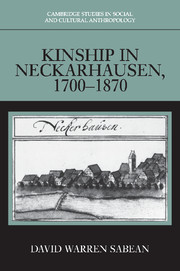Book contents
- Frontmatter
- Contents
- List of tables
- Abbreviations
- Abbreviations of sources
- On reading kinship diagrams
- Glossary
- Preface
- Introduction
- Cohort I (1700–1709)
- 4 Introduction to kinship during the early decades of the eighteenth century
- 5 Kinship as a factor in marriage strategy
- 6 Marriage and kinship practices
- 7 Ritual kinship
- 8 Naming children
- Cohort II (1740–1749)
- Cohort III (1780–1789)
- Cohort IV (1820–1829)
- Cohort V (1860–1869)
- Conclusion
- Appendix
- Bibliography
- General index
- Index of villagers
5 - Kinship as a factor in marriage strategy
Published online by Cambridge University Press: 04 August 2010
- Frontmatter
- Contents
- List of tables
- Abbreviations
- Abbreviations of sources
- On reading kinship diagrams
- Glossary
- Preface
- Introduction
- Cohort I (1700–1709)
- 4 Introduction to kinship during the early decades of the eighteenth century
- 5 Kinship as a factor in marriage strategy
- 6 Marriage and kinship practices
- 7 Ritual kinship
- 8 Naming children
- Cohort II (1740–1749)
- Cohort III (1780–1789)
- Cohort IV (1820–1829)
- Cohort V (1860–1869)
- Conclusion
- Appendix
- Bibliography
- General index
- Index of villagers
Summary
At the beginning of the eighteenth century, there were two basic coordinates for alliance formation between households and within and across generations. Inheritance, as already mentioned, distributed individuals onto a clearly marked-out social terrain and prescribed everyone's place in the village hierarchy. Initially, the position of any individual in the village wealth hierarchy was the outcome of birth into a particular family. Devolution established the framework in which marital strategies were worked out, and in contrast to later in the century when the market played a central role in the distribution of village resources, family and kin dynamics were largely circumscribed by inheritance.
The second coordinate of alliance formation was set by exogamy rules and practices (Chapter 3). Because such a large circle of consanguineal kin were not marriageable, alliances struck in a particular generation between householders could not be replicated easily in the following generations. For example, if two “houses” established close relations with each other through the exchange of spouses, the obvious way to reproduce the connection in the next generation was to have the children (now cousins) marry each other. Or the families could wait another generation to arrange marriages between the grandchildren (second cousins). But these sorts of strategies were closed to Württemberg villagers at the beginning of the eighteenth century, either as a result of direct prohibition from the state or because they were unwilling (or practically unable) to take recourse in the possibility of dispensations.
- Type
- Chapter
- Information
- Kinship in Neckarhausen, 1700–1870 , pp. 100 - 126Publisher: Cambridge University PressPrint publication year: 1997



